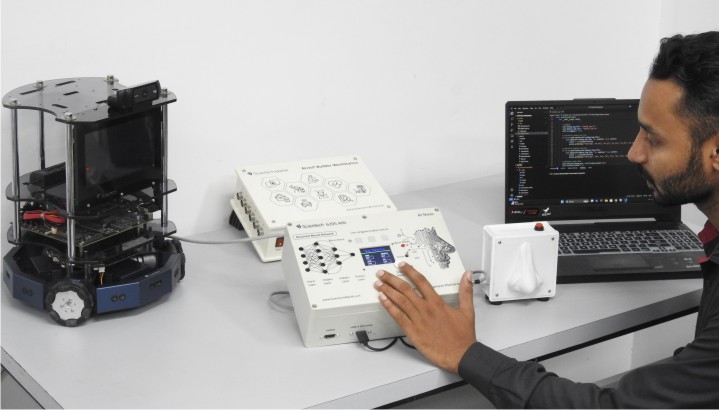Artificial Intelligence (AI) and Machine Learning (ML) are no longer emerging concepts – they are the driving force behind advancements in automation, smart devices, and data-driven decision-making. For engineering education, this means one thing: students need direct exposure to AI and ML technologies early in their academic journey.
AI/ML development platforms provide a practical, hardware-based solution to bridge the gap between theory and application. By offering real-time processing, model deployment, and system integration, these platforms make it possible for Computer Science Engineering (CSE) labs to deliver future-ready training.
What Are AI and ML Development Platforms?
AI/ML development platforms are compact embedded systems equipped with processors, memory, and often dedicated accelerators such as GPUs, TPUs, or NPUs. They are engineered to execute AI models efficiently and support applications in:
- Computer vision
- Natural language processing
- Robotics and automation
- Internet of Things (IoT) systems
Examples include:
- AI Development Platform for Sound & Motion Study
- Interactive AI Development Platform
- AI+IoT Builder WorkStation
- AIoT SerBot II
- AIoT AutoCar III G
- NVIDIA Jetson Nano / Xavier
Applications in Computer Science Engineering Labs
AI/ML hardware platforms allow students to apply classroom knowledge to real-world challenges. Typical applications include:
- Neural Network Deployment: Running and testing deep learning models.
- Image Processing Systems: Real-time object recognition and classification.
- Voice and NLP Solutions: Developing AI-powered assistants and chatbots.
- IoT with Edge AI: Integrating AI models into IoT devices for autonomous decision-making.
This combination of software and hardware helps students gain experience across domains that are directly relevant to industry.
Key Benefits for Educational Institutions
1. Practical Learning Environment
Students move beyond simulation and theory to building functional prototypes, strengthening both conceptual understanding and technical confidence.
2. Support for Interdisciplinary Projects
With the ability to connect sensors, cameras, and actuators, these platforms encourage innovation in robotics, healthcare, agriculture, and smart infrastructure.
3. Edge AI Capability
Processing data locally, without relying on cloud services, enables use cases such as environmental monitoring, surveillance systems, and autonomous drones.
4. Compatibility with Pre-Trained Models
Students can import models from frameworks like TensorFlow or PyTorch, fine-tune them, and optimize performance for constrained devices—skills in high demand across industries.
5. Alignment with Industry Tools
With support for CUDA, TensorRT, TensorFlow Lite, and other standard toolchains, students gain hands-on familiarity with the platforms used in professional environments.
6. Scalable and Cost-Effective Setup
Compared to GPU servers, development boards offer an affordable option for setting up multiple student workstations, making advanced AI education more accessible.
7. Fostering Research and Innovation
These platforms empower students to prototype solutions ranging from AI-driven mobility devices to automated attendance systems, turning labs into innovation hubs.
Preparing Students for an AI-Driven Future
AI and ML development platforms are transforming the way Computer Science is taught by combining practical experimentation with scalable learning tools. For institutions, investing in these platforms means preparing students with the technical expertise and problem-solving mindset needed for tomorrow’s industries.
At Scientech Technologies, we are committed to delivering robust, scalable, and industry-relevant AI/ML platforms that enable institutions to create impactful learning environments and nurture the engineers of the future.



